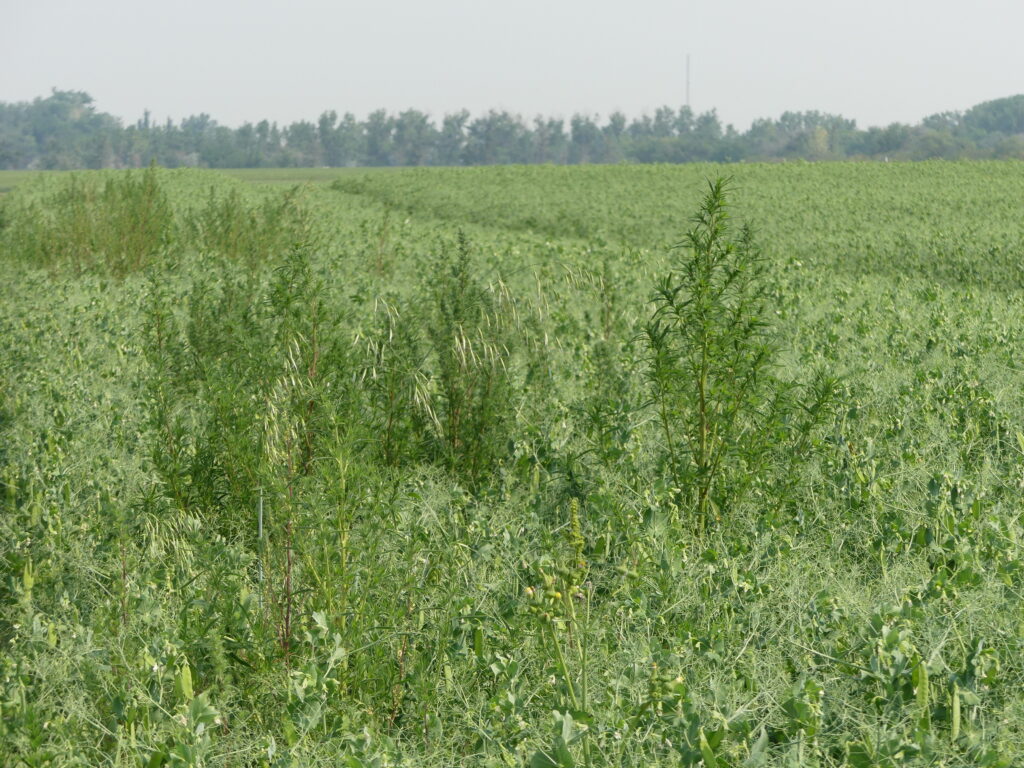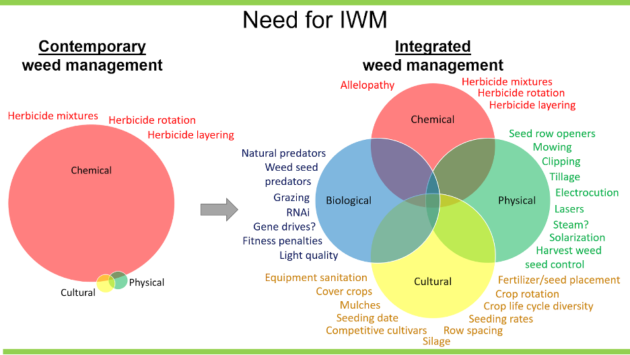
Features
Herbicides
Top Crop Summit
Weed Management
Top Crop Summit series: Herbicide resistant weeds in the Prairies
April 15, 2024 By Bruce Barker
 Kochia and wild oat are species of special interest for herbicide resistance.
Photo by Bruce Barker
Kochia and wild oat are species of special interest for herbicide resistance.
Photo by Bruce Barker Charles Geddes is a research scientist with Agriculture and Agri-Food Canada at Lethbridge, Alta. At the Top Crop Summit Feb. 27-28 in Saskatoon, he covered the discovery, occurrence, distribution and impact of herbicide-resistant weeds across the Canadian Prairies.
Herbicide-resistant weeds are a global issue, and in Canada, 86 unique types of herbicide-resistant weeds have been confirmed.
Since the 1930s, pesticide companies have released a steady number of new herbicide sites of action, totalling 21 active ingredients by the early 1980s. However, since then, only one new herbicide mode of action, Group 28, has been registered.
Pre-harvest herbicide-resistant weed surveys have been conducted approximately every five years on the Prairies since the early 2000s. The most recent surveys were conducted in Saskatchewan in 2019/2020, Manitoba in 2022 and Alberta in 2023.
In the recent Saskatchewan survey, of 419 fields surveyed, 72 per cent had herbicide-resistant weeds, estimated to cost Saskatchewan farmers approximately $340 million annually. The top five grassy weeds that were uncontrolled and present in annual crops prior to harvest were wild oat, green foxtail, barnyard grass, foxtail barley and annual brome spp. The top five broadleaf weeds were kochia, wild buckwheat, lamb’s quarters, Canada thistle and sow thistle spp.
Group 1 wild oat resistance was found on 77 per cent of fields tested, and Group 1 + 2 wild oat resistance was found on 26 per cent of fields tested.
In Saskatchewan, Group 2 resistance was found in many weed species, including kochia, for which all populations are assumed to be resistant. Other Group 2 resistant weeds confirmed at varying frequencies include wild oat, Russian thistle, false cleavers, pigweeds, spiny sow thistle, pale smartweed, shepherd’s purse, wild mustard, field pennycress, lamb’s quarters, hemp-nettle and chickweed.
In the 2022 Manitoba survey, 155 fields were surveyed, and 75 per cent of them had herbicide-resistant weeds. This was estimated to cost Manitoba farmers approximately $81 million annually. The top five grassy weeds that were uncontrolled before crop harvest were wild oat, green foxtail, barnyard grass, yellow foxtail and foxtail barley. The top five broadleaf weeds with resistance were pigweed spp., lamb’s quarters, wild buckwheat, kochia and pale smartweed.
Almost all wild oats tested for Group 1 resistance, and over 80 per cent had Group 1 + 2 resistance in Manitoba. Group 1 green foxtail resistance was high at over 80 per cent of tested fields. High levels of Group 2 resistance – over 75 per cent of tested fields – were found in wild oat, barnyard grass, kochia and pale smartweed.
The results from the 2023 Alberta survey are still being compiled.
Kochia is a species of special interest. In post-harvest surveys from 2018 through 2021, 889 sites were sampled for Group 9 glyphosate resistance. Twenty-six per cent of samples were still susceptible to glyphosate, but 31 per cent had a low resistance incidence up to 20 per cent, 28 percent had moderate resistance incidence up to 60 per cent and 15 per cent had a high resistance incidence over 60 per cent.
Group 4 Dicamba resistance has also been confirmed in kochia primarily in Alberta and Saskatchewan. Of 868 samples from across the Prairies, 76 per cent are still susceptible. Twenty-three per cent had a resistance incidence of less than 20 per cent of samples. Group 4 fluroxypyr kochia resistance has also been confirmed.
The development of herbicide resistance in kochia has been rapid. In the 2012 Alberta survey, 100 per cent of samples were found to be resistant to Group 2, and four per cent to Group 9 glyphosate. In the 2021 Alberta survey, again, 100 per cent of kochia populations sampled were assumed to be resistant to Group 2, but glyphosate resistance had grown to 78 per cent of sites, dicamba resistance was at 28 per cent and fluroxypyr was at 44 per cent.
In the Alberta survey, 10 per cent of samples had three-way resistance to glyphosate, dicamba and fluroxypyr.
Kochia herbicide resistance in Alberta

Source: Charles Geddes
Kochia has also recently been confirmed to be resistant to Group 14. Group 14 is a key herbicide group for controlling glyphosate and Group 4 resistant kochia. In dose-response trials, preliminary research is looking at kochia resistance in Group 14 products sulfentrazone, flumioxazin, saflufenacil, carfentrazone, acifluorfen, tiafenacil and pyraflufen-ethyl. Currently, no saflufenacil resistance has been found in 882 kochia samples collected across the Prairies between 2018 and 2021, but one sample collected from west-central Saskatchewan was resistant to all of these active ingredients except acifluorfen.
The challenge for growers is that kochia with multiple resistance to Group 2 + 4 + 9 + 14 is very difficult to control. This is especially the case for pea and lentil, where only two pre-emergent herbicides would control this multiple-resistant kochia, and no post-emergent herbicides would be effective. And in cereals, in-crop options rely heavily on Group 6 bromoxynil for control.
Weed management that heavily relies on chemical weed control needs to evolve into an integrated weed management strategy. These IWM strategies will incorporate chemical, biological, physical and cultural control.

Source: Charles Geddes